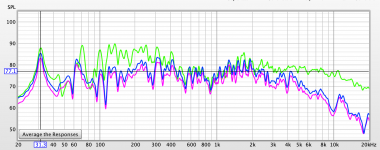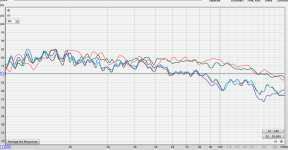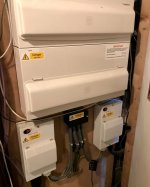Hello everyone,
Yet another fault in my system.....yawn.
I have a 211 power amp that has become duller/rolled off and when my brother came to visit now covid restrictions are lifted he commented how recessed and dull it sounded. He is into his AV and has a microphone connected to REW software and we compared 3 amplifier set ups and confirmed the source of the roll of was my 211 amp, by deduction. Same DAC, same leads from DAC to amp, and same speakers and speaker cables. Only change the amplifier, we also had a measurement from a friends system (same speakers, different room) this is the orange plot see below.
So the question is what could change to make an amplifier roll off this much, we are sure it never used to be rolled off (but don't have historical measurements) It's 18 years old and has been used in numerous systems at points and has never before sounded dull. It did not seem to change in one event, it's just gotten that way over the last few months I think, and I had shame on me, not really noticed by how much
Speakers in all plots are Klipsch Heresy III
First plot:
Green my old Denon UDM-31
Blue 211+ ARC SP8 preamp
Pink 211 into directly no preamp
second plot:
Green, same as above Denon UDM31
Orange, ARCSP10 + ARC D125
red, blues, all 211 amp, also with different 211 valve sets (V4TC GE)
so deduction is the 211 is rolling off, and the general question is what might change that could effect this amount of HF roll off, over time?
The sound is still good, and no other obvious fault.
The 211 Valve is drive by a 6C45 valve and an interstage transformer and the power supply is valve rectified 5U4GB, so I am getting new versions of these valves, but wondering what else to consider?
I am going to try and suss out the circuit, but don't have a diagram.
Any general thoughts of what could shift to result in roll off?
Thanks,
Yet another fault in my system.....yawn.
I have a 211 power amp that has become duller/rolled off and when my brother came to visit now covid restrictions are lifted he commented how recessed and dull it sounded. He is into his AV and has a microphone connected to REW software and we compared 3 amplifier set ups and confirmed the source of the roll of was my 211 amp, by deduction. Same DAC, same leads from DAC to amp, and same speakers and speaker cables. Only change the amplifier, we also had a measurement from a friends system (same speakers, different room) this is the orange plot see below.
So the question is what could change to make an amplifier roll off this much, we are sure it never used to be rolled off (but don't have historical measurements) It's 18 years old and has been used in numerous systems at points and has never before sounded dull. It did not seem to change in one event, it's just gotten that way over the last few months I think, and I had shame on me, not really noticed by how much
Speakers in all plots are Klipsch Heresy III
First plot:
Green my old Denon UDM-31
Blue 211+ ARC SP8 preamp
Pink 211 into directly no preamp
second plot:
Green, same as above Denon UDM31
Orange, ARCSP10 + ARC D125
red, blues, all 211 amp, also with different 211 valve sets (V4TC GE)
so deduction is the 211 is rolling off, and the general question is what might change that could effect this amount of HF roll off, over time?
The sound is still good, and no other obvious fault.
The 211 Valve is drive by a 6C45 valve and an interstage transformer and the power supply is valve rectified 5U4GB, so I am getting new versions of these valves, but wondering what else to consider?
I am going to try and suss out the circuit, but don't have a diagram.
Any general thoughts of what could shift to result in roll off?
Thanks,
Attachments
A stranger's first assumption would be that the amplifier has always been like that. We humans are very tolerant of some things, and this is an example of something we easily adjust to.
Just look at the number of high output impedance amplifiers folks extol in this very thread to give yourself a ballpark for acceptability re frequency response.
All good fortune,
Chris
Just look at the number of high output impedance amplifiers folks extol in this very thread to give yourself a ballpark for acceptability re frequency response.
All good fortune,
Chris
Yeah it is a possibility, except it has been used in multiple systems over the years and if anything the general view was that it was a tad brighter than duller if you had to call it compared to the amp it replaced.
Also before we tested it the first thing my brother said was it had lost projection and was recessed and a bit dull compared to how re remembered it. I had sort of the same POV over the last few days but had thought it was related to some preamplifier changes I had been making. The reason for testing was to look at the subwoofer integration originally.
Also before we tested it the first thing my brother said was it had lost projection and was recessed and a bit dull compared to how re remembered it. I had sort of the same POV over the last few days but had thought it was related to some preamplifier changes I had been making. The reason for testing was to look at the subwoofer integration originally.
I also had an old Naim Nait here that I confirmed worked ok before I sold it and again I did not think woooow that's bright when I tried it. That was about 12 months ago.
All unproven memory of course
All unproven memory of course
I'd try to replace the driver tube first.
It has a hell of a capacitance to drive (~150pf of the 211 plus some of the IT), and being worn off (= higher driver output impedance) it might be responsible for the roll off.
It has a hell of a capacitance to drive (~150pf of the 211 plus some of the IT), and being worn off (= higher driver output impedance) it might be responsible for the roll off.
Its possible if the gain of the valves has dropped a lot then the negative feedback will be much lower and the frequency response will revert to the open loop. I would expect distortion too though and early clipping.
Its possible if the gain of the valves has dropped a lot then the negative feedback will be much lower and the frequency response will revert to the open loop. I would expect distortion too though and early clipping.
The 211 amp has no feedback as I understand it, but I will find out in the next couple of days if it's a lot of discussion and distraction over nothing but tired valves!
If you do not use the amp for some time will it be better? Or is the roll-off getting worse after warming up?
I'm not sure, that "measuring" with -presumably - non professional measuring microphone (rather made for room correction) in not detailed measuring environment (nearfield? along which loudspeaker axis? at listening position? ...) the loudspeaker SPL produces any evaluable result for amplifier quality.
Some Klipsch loudspeaker has interesting impedance curve (especially over few kHz), so "measuring" it with low output impedance SS amplifiers and "high" impedance 211 amp gives a different result.
The 211 "optimal" primary reflected impedance is 16k, but good 16k:xR OPT is rare -and expensive-, most manufacturer use 10..12k transformers.
Most of this "commerce" transformers maybe have 20..25kHz HF bandwidth, but I measured even 12kHz -3dB point too.
Some Klipsch loudspeaker has interesting impedance curve (especially over few kHz), so "measuring" it with low output impedance SS amplifiers and "high" impedance 211 amp gives a different result.
The 211 "optimal" primary reflected impedance is 16k, but good 16k:xR OPT is rare -and expensive-, most manufacturer use 10..12k transformers.
Most of this "commerce" transformers maybe have 20..25kHz HF bandwidth, but I measured even 12kHz -3dB point too.
First I would measure the frequency response of the amp into a dummy load. Rule out one thing at a time.
I'm not sure, that "measuring" with -presumably - non professional measuring microphone (rather made for room correction) in not detailed measuring environment (nearfield? along which loudspeaker axis? at listening position? ...) the loudspeaker SPL produces any evaluable result for amplifier quality.
Some Klipsch loudspeaker has interesting impedance curve (especially over few kHz), so "measuring" it with low output impedance SS amplifiers and "high" impedance 211 amp gives a different result.
The 211 "optimal" primary reflected impedance is 16k, but good 16k:xR OPT is rare -and expensive-, most manufacturer use 10..12k transformers.
Most of this "commerce" transformers maybe have 20..25kHz HF bandwidth, but I measured even 12kHz -3dB point too.
This is super interesting - thanks.
Yes measuring with REW software and a Drayton non professional microphone, at the listening position ( Dayton Audio UMM-6 USB Measurement Microphone)
There is an assumption that the roll off measured in the same point in the room (microphone remains in position) with the same speakers, cables, same DAC, same software and MacBook to drive the test signal allows a direct comparison of the components in the system when the measured outcome differs.
My output transformers can be switched for output impedance and primary see image. So my simpleton thinking might be if I put the output tap on 4 ohms and the primary on 7.6K then use 8 ohm speaker do I get a reflected primary of ~15K?
Thanks for all the thinking!
If you do not use the amp for some time will it be better? Or is the roll-off getting worse after warming up?
Great idea to test, will try this later.....but I only have ears now as my brother and his test equipment are no longer here
oh here is a plot of 16 ohm tap vs 8 ohm tap on the output transformers.
They are nearly same output, blue is 16 ohm tap, red is 8 ohm.
I also left the Denon on here for comparison.
I know this is not 'accurate' but the roll of is sort of very similar and quite dramatic.
They are nearly same output, blue is 16 ohm tap, red is 8 ohm.
I also left the Denon on here for comparison.
I know this is not 'accurate' but the roll of is sort of very similar and quite dramatic.
Attachments
The difference in response, even with the crude available test bench, between 60 and 300 Hz should give you a clue to the cause of your concerns. Think it through.
All good fortune,
Chris
All good fortune,
Chris
It must be checked with the scope on a dummy load to see clearly the magnitude of the roll off , but if the amplifier doesn't use negative feedback it is not easy to achieve flat bandwidth . Then the transformers must be top quality .
Great idea to test, will try this later.....but I only have ears now as my brother and his test equipment are no longer here
Ears are fine !
You heard it first and then tested it, right?
Do you use transformers to filter your mains power line?
Ears are fine !
You heard it first and then tested it, right?
Do you use transformers to filter your mains power line?
Yeah heard it first and then tested.
No transformers - mains comes into house and splits into a separate 100A for the music room in an armoured cable and goes to a separate consumer unit just behind the back wall, which has 8 plugs individually wired to separate PCB off the CU with 30A cable. So sort of star config with low impedance. By far and away the cheapest mains improvement solution I have ever done (but easy for me as it was a new build).
The consumer units in the picture are for the normal domestic
Attachments
Did you build this amp yourself?
Do you have a photo?
My guess is that some power transformer is magnetizing a signal or output transformer in the amp...
Do you have a photo?
My guess is that some power transformer is magnetizing a signal or output transformer in the amp...
Last edited:
- Home
- Amplifiers
- Tubes / Valves
- Frequency Roll off changed - ideas



